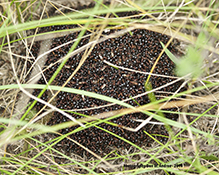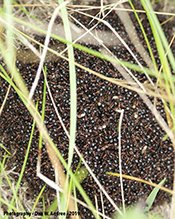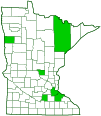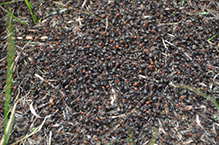Allegheny mound ant
(Formica exsectoides)
Conservation • Description • Habitat • Ecology • Distribution • Taxonomy
|
|
||||||||||||||
Description |
Allegheny mound ant is a large, bicolored, mound-building ant. It is found in the United States from Maine to Georgia, west to Colorado and New Mexico, and in adjacent Canadian Provinces. Within that range, it occurs only sporadically in the south, in the west, and in Canada. It is most common from New England to Illinois. It is uncommon in Minnesota. Workers are ⅛″ to 5 ⁄16″ (4.5 to 7.5 mm) long, black, and somewhat shiny. Winged males and queens are about the same size, 5 ⁄16″ to ⅜″ (8 to 9 mm) long. The body is divided into four easily distinguishable sections: the head; the first body section behind the head (mesosoma); the narrow, waist-like section (petiole); and the inflated rear section (gaster). The head and mesosoma are yellowish-red, light red, or medium red. The gaster is dark. The body is virtually hairless. Only the back of the gaster has erect hairs. The head is red and broadly rounded in outline. The rear margin is distinctly concave, an important distinguishing feature of this species. There are two large compound eyes on the sides of the head and three simple eyes (ocelli) in a triangle on the top of the head. The jaws (mandibles) have at least seven teeth. On the worker, the antennae have twelve segments, on the male they have thirteen. There is a hardened plate (clypeus) on the face above the mandibles. The clypeus is not notched or concave on its outer (anterior) margin. The antennae are inserted on the face well above the clypeus. The mesosoma is lumpy, not smoothly convex. It is covered with three exoskeletal plates, each forming a distinct bump. The first plate (pronotum) and second plate (mesonotum) cover the thorax. Together they are referred to as the promesonotum. The third plate (propodeum) covers the first segment of the abdomen which is fused to the thorax. When viewed from the side, the propodeum is distinctly lower than the level of the promesonotum. The petiole has a single raised bump (node). The gaster is bulbous and very dark brown, looking almost – but not – black. At the end of the gaster there is a tiny but distinctive nozzle (acidopore). The acidopore is fringed with hairs. |
Size |
Worker: ⅛″ to 5 ⁄16″ (4.5 to 7.5 mm) Male: 5 ⁄16″ to ⅜″ (8 to 9 mm) Queen: 5 ⁄16″ to ⅜″ (8 to 9 mm) |
Similar Species |
Ulke’s ant (Formica ulkei) head is dark on top, red below. The mesosoma is red, the gaster black. There are many erect hairs on the body. |
Habitat |
Open shrublands and woodlands, woodland edges and openings |
Ecology |
Season |
|
Behavior |
Workers are aggressive and will bite if their mound is disturbed. Using their acidopore, they inject formic acid into small trees and shrubs near their colony, killing those plants. They invade the nests of, and enslave, colonies of somewhat silky mound ant (Formica subsericea) and other ants in the fusca group of Formica ants. |
Life Cycle |
Allegheny mound ants build very large dome-shaped mounds (nests) that can be up to one meter high and two meters in diameter. The mounds are covered in soil, not thatch. They are often clustered. Adjacent mounds are often interconnected and they share foraging trails. Each mound can have up to twelve queens. |
Larva Food |
Plant sap and flower nectar |
Adult Food |
Mostly honeydew of aphids, scale insects, and tree hoppers, but they also prey on various insects. |
Distribution |
||
|
Sources |
|
| 5/10/2024 | ||
Occurrence |
||
Common in the east, uncommon in Minnesota. |
||
Taxonomy |
|
Order |
Hymenoptera (Ants, Bees, Wasps, and Sawflies) |
Suborder |
Apocrita (Narrow-waisted Wasps, Ants, and Bees) |
Infraorder |
Aculeata (Ants, Bees, and Stinging Wasps) |
Superfamily |
Formicoidea (ants) |
Family |
|
Subfamily |
Formicinae |
Tribe |
Formicini |
Genus |
|
Subordinate Taxa |
|
|
|
Synonyms |
|
Formica exsectoides exsectoides Formica exsectoides hesperia |
|
Common Names |
|
Allegheny mound ant |
|
Glossary
Clypeus
On insects, a hardened plate on the face above the upper lip (labrum).
Gaster
The bulbous part of the abdomen of ants, bees, and wasps. In ants it usually begins at segment three.
Mesosoma
In Hymenoptera: the front part of the body, consisting of all three segments of the thorax and the first segment of the abdomen, to which the wings are attached.
Ocellus
Simple eye; an eye with a single lens. Plural: ocelli.
Visitor Photos |
||
Share your photo of this insect. |
||
This button not working for you? |
||
James Folden |
||
some type of ant large ant mound (12" across, 4-6" tall) one of two seen in southeast corner of the prairie. Similar to the allegheny mound ant from what I can see on the website. |
||
Dan W. Andree |
||
Ant Colony..... Not sure what kind of ants they are but they were in a thick clump along the area I was walking. I do not think I have ever seen this kind of ant. Maybe fire ants or some other kind I haven’t seen around the yard or in town. I think they were carrying some larvae around. I did film them too. They did not come near me they just seemed so busy doing whatever they were doing. I often looked down to be sure none were crawling on me though I did remain 3-5 feet away. It was chilly out so I think maybe they didn’t notice me and had to get whatever they were doing done. I have never seen so many ants in a small area crawling on top each other etc. Sending a large resolution since they are small and maybe that will help identify them better or maybe you will know what they are doing. |
 |
|
 |
||
MinnesotaSeasons.com Photos |
||
|
||
|
||

Slideshows |
|

Visitor Videos |
||
Share your video of this insect. |
||
This button not working for you? |
||
James Folden |
Allegheny mound ant 01 |
About
Allegheny mound ant (Formica exsectoides) |
Other Videos |
||
alleghenyMoundAnt.MOv |
About
Published on May 16, 2011 Tired of lions ? Consider Formica exsectoides, aka the Allegheny Mound ant. |
Ant riot!!! |
About
Published on Jun 8, 2011 Formica Exsectoides - Allegheny mound ant. |
Alleghaney mound ants |
About
Published on Jul 18, 2016 On the surface of a large Alleghany mound ant nest workers busily reposition grains of soil, while on a nearby foraging trail some workers return to the colony with food as others pass to pick up their loads. |
allegheny mound ant foraging trail |
About
Published on Aug 6, 2017 Allegheny mound ants on a foraging trail |

Visitor Sightings |
||
Report a sighting of this insect. |
||
This button not working for you? |
||
Aubree Tschudy |
Location: Saint Cloud, MN |
MinnesotaSeasons.com Sightings |
||

Created: 9/24/2019 Last Updated: © MinnesotaSeasons.com. All rights reserved. |



